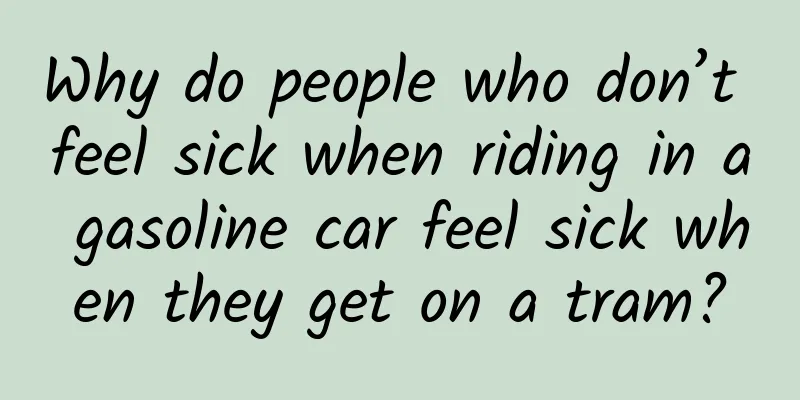Why do people who don’t feel sick when riding in a gasoline car feel sick when they get on a tram?

|
Why do people who don’t feel sick when riding in a gasoline car feel sick when they get on a tram? I believe many people have had this experience. I am fine at other times, but why do I get carsick when I book a ride online? The dizziness, nausea, chest tightness, and even pale complexion, vomiting and diarrhea are really unbearable to look back on... I want to tell the driver: Get off, I'll drive! It's really not a technical problem of the drivers. Why is that? Let's take a look. Why do people get carsick? Motion sickness is also called "motion sickness". It refers to a series of uncomfortable reactions that occur when the human body is exposed to a stimulating motion environment (whether you are riding in a car, boat or plane), such as dizziness, fatigue, cold sweats, stomach discomfort, nausea and vomiting, hyperventilation, etc. Although everyone has a relatively clear understanding of the symptoms of motion sickness, there is still no clear answer to its cause. **The most widely adopted one is the sensory conflict hypothesis: **Motion sickness occurs when the motion information perceived by the sensory system is contradictory; when there is a conflict between the actual incoming sensory information such as vision, kinesthetic sense, and position sense and the sensory information expected by the human body based on past experience. In short, motion sickness is mainly related to our eyes and ears. The eyes directly perceive whether we are moving by observing changes in the environment. The ears have a sophisticated balance perception system - the vestibular system, which can sense whether we are really moving, whether we are going uphill or downhill, whether we are accelerating or decelerating, and whether we are moving horizontally or vertically. Under normal circumstances, the information provided by the eyes and ears (vestibular system) should be consistent . However, when sitting in a shaking car, the eyes and the movement of the car are relatively still, and the images seen are relatively stable; while the ears are strongly stimulated during the bumps and changes in direction. This leads to differences in the information they receive. Ear: You moved Eyes: You didn't move At this time, the brain receives two inconsistent reports, which makes it a little dizzy. This is why many people are not prone to motion sickness when driving themselves, because the driver actively controls the car by holding the steering wheel and stepping on the accelerator. Every movement of the body notifies the brain: we are moving, we are really moving! As long as the brain can perceive the connection between human movements and motions, and can predict changes in direction and acceleration and deceleration, it can get by and think that everything is harmonious, and people are not prone to motion sickness. Why do people get more carsick when riding in a train than when riding in a gasoline car? Many people think that online ride-hailing cars are more prone to motion sickness, and that’s true. This is not a psychological effect, but the new energy electric vehicles commonly used in this industry will increase the probability of motion sickness . If autonomous driving is involved, the incidence of motion sickness will increase by 17.24% compared to traditional vehicles. Why? Compared with traditional fuel vehicles, electric vehicles are better than traditional fuel vehicles in making the brain produce the illusion that "I am not moving". In fact, it is very easy to understand. The biggest difference between electric vehicles and gasoline vehicles is the different power performance, and there is also energy recovery. The starting torque of a fuel vehicle rises slowly, and the vehicle accelerates slowly, giving people a reaction time, but the electric vehicle accelerates very quickly from zero to maximum torque. Most electric vehicles have a kinetic energy recovery system when braking, the purpose is to save electricity and energy. However, the kinetic energy recovery system of a large number of models is very abrupt, and the passengers in the car will feel a sense of drag, which increases the discomfort . Such performance determines that electric vehicles accelerate and brake faster and more suddenly, and are closer to the popular driving technique of "one foot on the accelerator and one foot on the brake", which creates a stronger sense of sensory mismatch in the brain. In addition, the sound of an electric car engine is much lighter than the roar of a traditional fuel engine, and the vibration is also smaller. This "quietness" makes passengers unable to predict when the vehicle will start and accelerate, and there is no white noise to distract their attention. Therefore, this "illusion" will be exacerbated. Is there any way to improve it? The quickest and most effective way to deal with motion sickness is to get off the car immediately, but this may be inconvenient in daily travel. If you want to effectively improve the experience of motion sickness, you can try the following methods: 1. Swing to build tolerance People with a history of motion sickness can strengthen vestibular function exercises, take more car rides or do some rotating, tumbling and other exercises to adjust, such as swinging on a swing. Swinging can also help train one's sense of space and improve the ability to grasp the direction of spatial dimensions. 2. Open windows for ventilation If you feel stuffy, open the window to ventilate, stop the car and walk around in compliance with regulations and to ensure safety, and do not put pungent perfumes, sachets, etc. in the car. (Or either look out the window more often or close your eyes to rest) 3. Put on motion sickness patch half an hour in advance It takes time for the skin to absorb the drug, so motion sickness patches should usually be used half an hour before getting on the bus. Sticking them behind the ears and on the navel can significantly relieve symptoms of dizziness, nausea, and cold sweats. The effect of motion sickness patches generally lasts about 6 hours, but sometimes the ride is long and the distance is long, so if used continuously, the patches should be rotated; after using two patches continuously, it is best to wait at least 6 hours before using the third patch. 4. Carry some orange peels with you If you often feel dizzy when riding in a car, you can bring a piece of fresh orange peel and smell it when you feel uncomfortable. 5. Sit in the front row if possible The vision in the back seat is poor. When the balance organs in the ears are adapting to a movement, the eyes cannot determine whether they are moving or still, making motion sickness more likely to occur. 6. Distract Distract your attention by listening to music, chatting or sleeping, but do not look at your phone or read books to avoid aggravating motion sickness. It is important to say it three times: Don’t play with your phone, don’t play with your phone, and don’t play with your phone! |
<<: Why do I always have a lot of ideas when I take a shower? It turns out it’s because…
Recommend
Behind the sharp drop in China Unicom's revenue growth: FDD is to blame
China Unicom's first-half financial report re...
New fabric allows secure payments and health monitoring with a swipe of the sleeve
With the rapid development of science and technol...
6 minutes to fully understand the App message push strategy
Proper use of push can help product operators ach...
400 phone procedure? How to apply for a 400 phone number?
Since its launch, 400 telephone has been consider...
A nanny-level guide for beginners to create Tik Tok videos (Part 1)
Today, I will introduce to you some tips on how t...
AI has helped reduce in-flight food waste by 63%. How did it do that?
How AI can help airlines reduce food waste on boa...
Beijing Hyundai is caught in a production suspension crisis: it owes suppliers 111 million yuan and is cut off from supply
Beijing Hyundai, which has surpassed the annual s...
2019 Complete Plan for Online Event Promotion!
How to plan an online event? Even those who are j...
Does the world need Xiaomi?
Celebrity appearances, live streams by internet c...
10 practical strategies to attract new users!
When it comes to product operation , the main tas...
When Ai Fejieni, one of the top three contestants of "The Rap of China", encountered Baidu's campus recruitment, what kind of opportunity was this?
On the evening of September 9, the final of "...
Android 8.0, the savior of domestic mobile phones, is coming soon, and its fluency is comparable to that of Apple iOS
Android and Apple have been fighting for so many ...
Red Planet · Introduction to short videos in physical stores, how to shoot and edit ideas, Dou Pod is worth 999 yuan
Red Planet·Introduction to short videos in physic...
National Primary and Secondary School Students Safety Education Day丨"Naughty children" playing with fire in the elevator almost caused a disaster! Please remember the fire safety knowledge
Today is the 27th National Safety Education Day f...
Can Ping An continue to be “peaceful”?
Ping An's IPO price in Hong Kong in 2004 was ...









